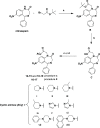New Insights into the Structure-Activity Relationship and Neuroprotective Profile of Benzodiazepinone Derivatives of Neurounina-1 as Modulators of the Na+/Ca2+ Exchanger Isoforms
- PMID: 34845907
- PMCID: PMC8713167
- DOI: 10.1021/acs.jmedchem.1c01212
New Insights into the Structure-Activity Relationship and Neuroprotective Profile of Benzodiazepinone Derivatives of Neurounina-1 as Modulators of the Na+/Ca2+ Exchanger Isoforms
Abstract
Due to the neuroprotective role of the Na+/Ca2+ exchanger (NCX) isoforms NCX1 and NCX3, we synthesized novel benzodiazepinone derivatives of the unique NCX activator Neurounina-1, named compounds 1-19. The derivatives are characterized by a benzodiazepinonic nucleus linked to five- or six-membered cyclic amines via a methylene, ethylene, or acetyl spacer. The compounds have been screened on NCX1/NCX3 isoform activities by a high-throughput screening approach, and the most promising were characterized by patch-clamp electrophysiology and Fura-2AM video imaging. We identified two novel modulators of NCX: compound 4, inhibiting NCX1 reverse mode, and compound 14, enhancing NCX1 and NCX3 activity. Compound 1 displayed neuroprotection in two preclinical models of brain ischemia. The analysis of the conformational and steric features led to the identification of the molecular volume required for selective NCX1 activation for mixed NCX1/NCX3 activation or for NCX1 inhibition, providing the first prototypal model for the design of optimized isoform modulators.
Conflict of interest statement
The authors declare no competing financial interest.
Figures













Similar articles
-
Neurounina-1, a novel compound that increases Na+/Ca2+ exchanger activity, effectively protects against stroke damage.Mol Pharmacol. 2013 Jan;83(1):142-56. doi: 10.1124/mol.112.080986. Epub 2012 Oct 11. Mol Pharmacol. 2013. PMID: 23066092
-
Three Na+/Ca2+ exchanger (NCX) variants are expressed in mouse osteoclasts and mediate calcium transport during bone resorption.Endocrinology. 2007 May;148(5):2116-25. doi: 10.1210/en.2006-1321. Epub 2007 Feb 22. Endocrinology. 2007. PMID: 17317768
-
Pharmacological characterization of the newly synthesized 5-amino-N-butyl-2-(4-ethoxyphenoxy)-benzamide hydrochloride (BED) as a potent NCX3 inhibitor that worsens anoxic injury in cortical neurons, organotypic hippocampal cultures, and ischemic brain.ACS Chem Neurosci. 2015 Aug 19;6(8):1361-70. doi: 10.1021/acschemneuro.5b00043. Epub 2015 May 19. ACS Chem Neurosci. 2015. PMID: 25942323
-
New roles of NCX in glial cells: activation of microglia in ischemia and differentiation of oligodendrocytes.Adv Exp Med Biol. 2013;961:307-16. doi: 10.1007/978-1-4614-4756-6_26. Adv Exp Med Biol. 2013. PMID: 23224890 Review.
-
The Na+/Ca2+exchanger in Alzheimer's disease.Cell Calcium. 2020 May;87:102190. doi: 10.1016/j.ceca.2020.102190. Epub 2020 Mar 2. Cell Calcium. 2020. PMID: 32199208 Review.
Cited by
-
Excitatory Synaptic Transmission in Ischemic Stroke: A New Outlet for Classical Neuroprotective Strategies.Int J Mol Sci. 2022 Aug 19;23(16):9381. doi: 10.3390/ijms23169381. Int J Mol Sci. 2022. PMID: 36012647 Free PMC article. Review.
-
Structure-Based Function and Regulation of NCX Variants: Updates and Challenges.Int J Mol Sci. 2022 Dec 21;24(1):61. doi: 10.3390/ijms24010061. Int J Mol Sci. 2022. PMID: 36613523 Free PMC article. Review.
-
Anti-miRNA103/107 encapsulated in transferrin-conjugated lipid nanoparticles crosses blood-brain barrier and reduces brain ischemic damage.Mol Ther Nucleic Acids. 2024 Feb 2;35(1):102131. doi: 10.1016/j.omtn.2024.102131. eCollection 2024 Mar 12. Mol Ther Nucleic Acids. 2024. PMID: 38379726 Free PMC article.
-
Stereoselective [4+3]-Cycloaddition of 2-Amino-β-nitrostyrenes with Azaoxyallyl Cations to Access Functionalized 1,4-Benzodiazepin-3-ones.Molecules. 2024 Mar 8;29(6):1221. doi: 10.3390/molecules29061221. Molecules. 2024. PMID: 38542858 Free PMC article.
References
MeSH terms
Substances
LinkOut - more resources
Full Text Sources
Miscellaneous

